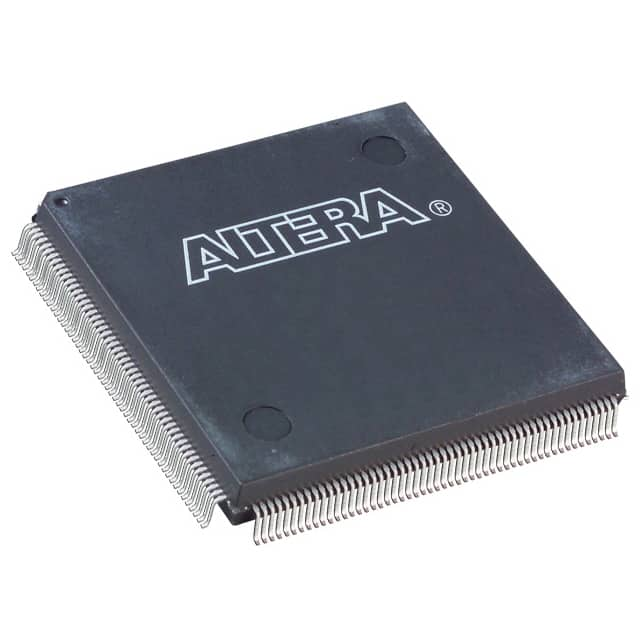Lihat spesifikasi untuk detail produk.

EP1K50QC208-3
Product Overview
Category: Integrated Circuit (IC)
Use: The EP1K50QC208-3 is a programmable logic device (PLD) that belongs to the family of Altera's MAX 7000 series. It is designed for various digital applications, including data processing, control systems, and communication devices.
Characteristics: - High-performance programmable logic device - Low power consumption - Compact size - Versatile functionality - Reliable performance
Package: The EP1K50QC208-3 is available in a Quad Flat Package (QFP), which ensures easy installation and compatibility with standard PCB designs.
Essence: This IC serves as a key component in electronic systems, providing flexible and customizable logic functions to meet specific application requirements.
Packaging/Quantity: The EP1K50QC208-3 is typically sold in reels or trays, containing a quantity of 250 units per package.
Specifications
The EP1K50QC208-3 offers the following specifications:
- Logic Elements: 1,536
- Maximum User I/Os: 117
- Embedded Multiplier Blocks: 4
- Total RAM Bits: 36,864
- Maximum Operating Frequency: 200 MHz
- Supply Voltage: 3.3V
- Operating Temperature Range: -40°C to 85°C
Detailed Pin Configuration
The EP1K50QC208-3 has a total of 208 pins, each serving a specific purpose within the circuit. The detailed pin configuration can be found in the manufacturer's datasheet.
Functional Features
The EP1K50QC208-3 offers several functional features that enhance its usability and performance:
Programmability: The device can be programmed using industry-standard hardware description languages (HDL) such as VHDL or Verilog, allowing for customization and adaptability to various applications.
Flexible I/O Options: The IC provides a wide range of input/output options, enabling seamless integration with other components and peripherals.
Embedded Multiplier Blocks: The built-in multiplier blocks facilitate efficient multiplication operations, reducing the need for additional external circuitry.
On-Chip Memory: The EP1K50QC208-3 includes embedded RAM blocks, providing convenient storage for data and intermediate results.
Advantages and Disadvantages
Advantages: - High-performance capabilities - Low power consumption - Compact size for space-constrained designs - Versatile functionality for diverse applications - Reliable performance for long-term operation
Disadvantages: - Limited number of user I/Os compared to higher-end models - Relatively higher cost compared to simpler logic devices
Working Principles
The EP1K50QC208-3 operates based on the principles of programmable logic. It consists of configurable logic blocks (CLBs), interconnect resources, and I/O elements. The CLBs can be programmed to implement various logic functions, while the interconnect resources enable communication between different blocks. The I/O elements provide connectivity to external devices.
Upon programming, the EP1K50QC208-3 executes the desired logic functions based on the input signals received through its I/O pins. The output signals are then generated according to the programmed logic, facilitating the desired behavior of the electronic system.
Detailed Application Field Plans
The EP1K50QC208-3 finds applications in a wide range of fields, including:
Industrial Automation: It can be used in control systems for manufacturing processes, robotics, and machinery.
Communications: The device is suitable for implementing digital signal processing algorithms in communication systems, such as modems and routers.
Data Processing: It can be utilized in data centers and servers for accelerating computational tasks and improving overall system performance.
Consumer Electronics: The EP1K50QC208-3 can be integrated into consumer devices like gaming consoles, set-top boxes, and smart appliances to enhance functionality and processing capabilities.
Detailed and Complete Alternative Models
- EP1K30QC208-3: A lower-capacity variant of the EP1K50QC208-3 with 1,280 logic elements and 96 user I/Os.
- EP1K100QC208-3: A higher-capacity variant of the EP1K50QC208-3 with 2,560 logic elements and 144 user I/Os.
- EP1K10TC144-3: A cost-effective alternative with reduced logic capacity (640 elements) and limited temperature range (-40°C to 70°C).
These alternative models provide options for different project requirements, allowing users to select the most suitable device based on their specific needs.
In conclusion, the EP1K50QC208-3 is a high-performance programmable logic device that offers versatility,
Sebutkan 10 pertanyaan dan jawaban umum terkait penerapan EP1K50QC208-3 dalam solusi teknis
Sure! Here are 10 common questions and answers related to the application of EP1K50QC208-3 in technical solutions:
Q1: What is EP1K50QC208-3? A1: EP1K50QC208-3 is a specific model of field-programmable gate array (FPGA) manufactured by Altera.
Q2: What are the key features of EP1K50QC208-3? A2: EP1K50QC208-3 offers 50,000 logic elements, 3.3V operation, and comes in a 208-pin quad flat pack (QFP) package.
Q3: What are some typical applications of EP1K50QC208-3? A3: EP1K50QC208-3 can be used in various applications such as digital signal processing, industrial automation, telecommunications, and embedded systems.
Q4: Can EP1K50QC208-3 be reprogrammed after deployment? A4: Yes, EP1K50QC208-3 is a field-programmable device, which means it can be reprogrammed even after it has been deployed in a system.
Q5: What programming languages can be used with EP1K50QC208-3? A5: EP1K50QC208-3 can be programmed using hardware description languages (HDLs) such as VHDL or Verilog.
Q6: What development tools are available for EP1K50QC208-3? A6: Altera provides Quartus Prime software suite, which includes design entry, synthesis, simulation, and programming tools for EP1K50QC208-3.
Q7: Can EP1K50QC208-3 interface with other components or devices? A7: Yes, EP1K50QC208-3 supports various communication protocols and can interface with other components or devices using standard interfaces like SPI, I2C, UART, etc.
Q8: What is the power supply requirement for EP1K50QC208-3? A8: EP1K50QC208-3 operates at a voltage of 3.3V and requires a stable power supply within the specified voltage range.
Q9: Can EP1K50QC208-3 handle real-time processing tasks? A9: Yes, EP1K50QC208-3 is capable of handling real-time processing tasks due to its high-speed logic elements and configurable architecture.
Q10: Are there any limitations or considerations when using EP1K50QC208-3? A10: Some considerations include power consumption, heat dissipation, and the need for proper grounding and decoupling techniques to ensure reliable operation. Additionally, understanding the device's datasheet and programming requirements is crucial for successful implementation.
Please note that these answers are general and may vary depending on specific application requirements and design considerations.

